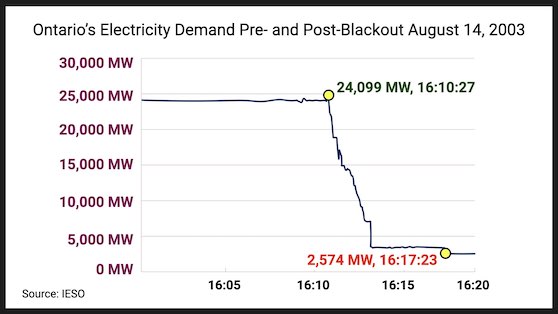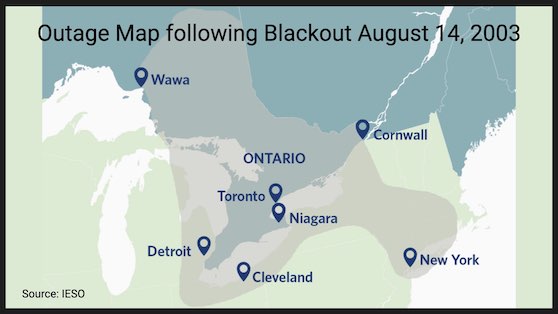
Articles
Features
News
News
Energy & Power
Transmission & Distribution
Believe it or not, it’s been 20 years since the Northeast Blackout of 2003
August 14, 2023 | By Anthony Capkun
 Notice how electricity demand plunged during the first few minutes of the blackout. Source: IESO
Notice how electricity demand plunged during the first few minutes of the blackout. Source: IESO August 14, 2023 – 20 years ago today, a blackout across the northeast left more than 50 million people across eight U.S. states and most of Ontario without power.
At 4:11 pm on August 14, 2003, a series of cascading faults—triggered by unkept tree branches interfering with sagging power lines in Ohio—led to the largest blackout in North American history.
Human error, software issues, and equipment failures contributed to these degraded conditions, leading to large power swings pulsing into Ontario through Michigan and New York and overloading the system.
Representing 61,800 MW of load, millions of customers lost power. Nearly all Ontarians living east of Wawa were without power, with small pockets of electricity remaining in Niagara and Cornwall.

While most Ontario customers lost power, the system was able to maintain electricity service in pockets throughout the province. These pockets would play a role in re-energizing the system. Source: IESO.
Ontario’s power system was restored within 30 hours, yet the state of emergency remained in effect until August 22 while the province’s generation fleet was brought back to full production capability.
Conservation was critical during this period, with homeowners and businesses reducing peak demand by 15% to 20% each day.
In 2004, a Canada-U.S. task force made 46 recommendations to help prevent future blackouts, stressing the importance of mandatory and enforceable standards as well as training programs that were already in place in Ontario. Other provinces and states have since adopted mandatory and enforceable reliability standards.
Every year, Ontario’s Independent Electricity System Operator (IESO) conducts emergency simulations and training sessions to ensure grid operators and partners have the skills, tools, and capabilities to manage system events. IESO reports it also plans the system to ensure there are sufficient redundancies and supply cushions to mitigate potential problems on the transmission system or at generation facilities.
— With files from the Independent Electricity System Operator.
Print this page